PREVENTIVE CARE
DENTAL XRAYS
Dental xrays are a valuable part of detecting oral health problems at an early stage. Many oral diseases cannot be detected with a physical examination alone.
Dental xrays help provide information about the patient’s oral health such as early-stage cavities, alveolar bone loss, abcesses or cysts, developmental abnormalities, root positions and some types of tumors.
 |
- How often dental xrays should be taken depends on the patient’s oral health condition, age, risk of disease and any signs and symptoms of oral disease that the patient might be experiencing.
- If you have concerns, talk to your dentist but eliminating xrays altogether could be detrimental to your oral health.
|
DENTAL
PROPHYLAXIS (DENTAL CLEANING)
| Dental cleaning is a routine dental procedure and a part of preventive care which usually takes 45 minutes to one hour visit. The hardened
plaque (calculus) and sticky film (plaque) that adheres on the teeth and below the gum line are removed with hand scalers and ultrasonic
cavitron (ultrasonic instrument that uses high frequency vibration and water). Once the calculus and plaque are removed, the teeth are polished to remove stains and plaque. |
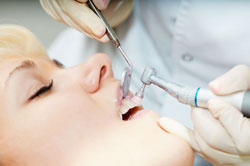 |
DENTAL SEALANTS
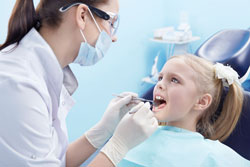 |
Dental sealants can protect tooth enamel and seal them off from decay-causing bacteria. Sealants are made of plastic and are applied to the chewing surfaces of the back teeth to prevent decay. Sealants are easily applied and it takes only few minutes to seal each tooth. We first clean the teeth that will be sealed, roughen the chewing surfaces with an acid solution( which will help the sealant stick to the teeth). The teeth are rinsed with water, then we apply air to dry the teeth and “paint” the sealant on the tooth. We use a light cure to harden the sealant. As long as the sealant remains intact, the tooth surface will be protected from decay. Sealants hold up well under the force of normal chewing but may have to be reapplied if needed. Both primary and permanent teeth can benefit from sealants. |
FLUORIDE
| Fluoride helps to prevent tooth decay by making the tooth more resistant to acid and bacteria. Infants and children between the ages of 6 months and 16 years should receive fluoride. Their primary teeth and permanent teeth develop during these ages. Fluoride can be applied directly to teeth through toothpastes and mouth rinses that contain fluoride. Dentists can also apply fluoride directly to your teeth in the form of a gel, foam or varnish. |
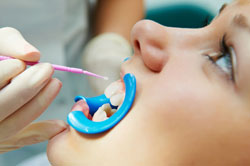 |
Additional fluoride treatment can benefit children and adults with certain oral conditions, including dry mouth, gum disease, and cavities.
It is very important to monitor the amounts of fluoride. If too much fluoride is consumed while the teeth are developing, a condition called fluorosis may result. Fluorosis often appears as unnoticeable, tiny white streaks or specks in the enamel of the tooth. This condition can be cosmetically treated with conservative restorations.
HOME CARE
Oral health means more than just an attractive smile. Poor oral health and untreated oral diseases and conditions can have a significant impact on quality of life. The condition of the mouth mirrors the condition of the body as a whole. It is important to visit your dentist regularly and practice good oral hygiene at home.
BRUSHING BASICS
Remember your 2s: 2 minutes, 2 times a day. Everyone in your family should be brushing their teeth for at least 2 minutes every time they brush-and they should be brushing their teeth twice a day.
There are easy ways to make brushing fun and ensure. Turn on your favorite song and listen while you brush. Most songs are at least two minutes long-sometimes longer. Are your kids struggling while brushing for the full two minutes? Visit www.2min2x.org! There you will find a bunch of fun videos-all 2 minutes in length-that will keep them entertained while brushing their teeth.
- One effective, easy-to-remember technique involves using a circular or elliptical motion to brush a couple of teeth at a time, gradually covering the entire mouth.
- Place the toothbrush beside your teeth at a 45-degree angle and gently brush teeth in an elliptical motion. Brush the outside of the teeth, inside the teeth, your tongue, the chewing surfaces of your teeth, and in between teeth.
- Never use a back and forth motion-this causes the gum surface to recede an can expose the root surface or make the root surface tender.
|
 |
FLOSSING
Flossing at least once a day and spend at least two or three minutes.
 |
Dental floss comes in many forms: waxed and unwaxed, flavored and unflavored, wide(dental tape) and regular. They all remove plaque and debris the sticks to teeth and gums in between teeth, polishes tooth surfaces and controls bad breath. |
Methods of Flossing:
The Spool Method: Take an 18-inch piece of floss and wind the bulk of the floss lightly around the middle finger.(Don’t cut off your finger’s circulation!) Wind the rest of the floss similarly around the same finger of the opposite hand. This finger takes up the floss as it becomes unusable. Maneuver the floss between the teeth with your index fingers and thumbs. Bring the floss up and down several times forming a “C” shape around the tooth being sure to go below the gum line.
The Loop Method: This method is suited for children and adults with less nimble hands, poor muscular coordination or arthritis. Take an 18-inch piece of floss and make it into a circle. Tie it securely with three knots. Place all of the fingers, except the thumb, within the loop. Use your index fingers to guide the floss through the lower teeth, and use your thumbs to guide the floss through the upper teeth, going below the gum line forming a “C”on the side of the tooth.
RINSING
A mouth rinse , in addition to daily brushing and flossing, can increase the cleanliness of your mouth. Antimicrobial mouth rinses reduce bacteria and plaque activity, which causes gingivitis and gum disease. Fluoride mouth rinses also help reduce and prevent tooth decay. Always check the manufacturer’s label for precautions and age recommendations and talk with your dentist about the use of fluoride mouth rinse.
OTHER DENTAL AIDS:
| INTERDENTAL
BRUSHES (PROXY BRUSH) -provides effective cleaning around the dental bridges, orthodontic braces, wide interdentally spaces helping the teeth clean and healthy. |
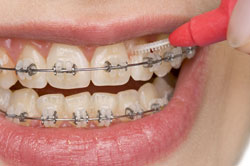 |
|
END-TUFTED BRUSH - perfect for cleaning specific, difficult to reach areas between the crowns, bridgework and crowded teeth. This also allows to pinpoint small, hard to reach spaces. |
|
WATERPIK - This should not be used as a substitute for brushing and flossing. They are effective, however, around orthodontic braces that retain food in areas a toothbrush cannot reach. Unlike flossing, waterpiks do not remove plaque. This is also recommended for patients with gum disease. |
NUTRITION AND DIET
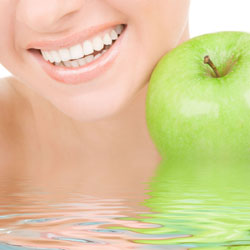 |
Eating patterns and food choices play an important role in preventing tooth decay. Your mouth is your body’s initial point of contact with the nutrients you consume. So what you put in your mouth impacts not only your general health but also that of your teeth and gums. In fact, if your nutrition is poor, the first signs often show up in your oral health. Your individual nutrition and calorie needs depend on your age, gender, level of physical activity and other health factors. A balanced and healthy diet should include fruits and vegetables, grains, dairy, and protein
(http://www.choosemyplate.gov)
In addition to diet, it is also important to stay active for good health. Adults should get at least two and a half hours of moderate-intensity physical activity every week.
|
Diet and Tooth Decay
The foods you eat and the beverages you drink can have a direct influence on the incidence and progression of tooth decay, depending upon:
- The form of the food- whether it’s liquid, solid, sticky or slow to dissolve makes a difference.
- How often you eat sugary foods and beverages and how often you eat or drink acidic foods and beverages.
- The nutritional makeup of the food.
- The combination of the foods you eat and the order in which you eat them.
- Medical conditions you may have, such as gastrointestinal reflux and eating disorders, which can increase risk of cavities and weaken teeth.
Foods That May Harm Dental Health
- Empty calorie foods such as
candies (hard or sticky such as taffy, caramel, lollipops, mints), sweets like cookies, cakes, muffins, and snack foods like chips are a cause for dental concern, not only because they offer no nutritional value, but because the amount and type of sugar that they contain that can adhere to teeth. The bacteria in your mouth feed off these sugars, releasing acids, and that’s what leads to tooth decay.
- Sugar-containing drinks- soda, lemonade, juice and sweetened coffee or tea (iced or hot) - are particularly harmful because sipping them causes a constant sugar bath over teeth, which promotes tooth decay.
- Nutritious, acidic foods like tomatoes and citrus fruits can have acidic effects on tooth enamel too, so eat them as part of a meal, not by themselves. Dried fruits, including raisins, are also good choices for a healthy diet, but since they are sticky and adhere to teeth, the plaque acids that they produce continue to harm teeth long after you stop eating them. Opt for a piece of fresh fruit instead.
Foods That May Benefit Dental Health
- Cheese, milk, plain yogurt, calcium-fortified tofu, leafy greens and almonds, contain high amounts of calcium. Protein-rich foods like meat, poultry, fish, milk and eggs are the best sources of phosphorus. Both of these minerals protect our tooth enamel.
- Fruits and vegetables are good choices for a healthy smile since they are high in water and fiber, which balance the sugars they contain and help to clean the teeth. These foods also help stimulate saliva production, which washes harmful acids and food particles away from teeth and helps neutralize acid, protecting teeth from decay. They also contain vitamin
C (important for healthy gums and quick healing of wounds) and vitamin
A (building tooth enamel).
|